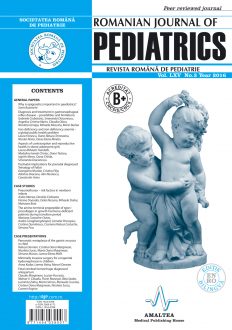SELECT ISSUE

Indexed

| |

|
|
|
| |
|
|
|

|
|
|
|
|
|
|
HIGHLIGHTS
National Awards “Science and Research”
NEW! RJP has announced the annually National Award for "Science and Research" for the best scientific articles published throughout the year in the official journal.
Read the Recommendations for the Conduct, Reporting, Editing, and Publication of Scholarly work in Medical Journals.
The published medical research literature is a global public good. Medical journal editors have a social responsibility to promote global health by publishing, whenever possible, research that furthers health worldwide.
HEMORAGIA CEREBRALA FETALA DIAGNOSTICATA ANTEPARTUM
Bela Szabo, Claudiu Mărginean, Claudiu V. Molnar, Cosmin Rugina, Cristina Oana Mărginean, Florin Rozsnyai, Lucian Puscasiu, Luminita Zahiu, Manuela Cucerea, Marta Simon and Nicoleta Suciu
REZUMAT
Diagnosticul antepartum al hemoragiei cerebrale fetale (HCF) este mai puţin raportat (0,9/1.000 naşteri) comparativ cu cel postpartum. Sunt prezentate două cazuri de hemoragie intraventriculară fetală, diagnosticate ecografic antepartum.
Cazul 1: HCF diagnosticată ecografic la vârsta gestaţională de 28 de săptamâni de gestaţie şi confirmată postnatal prin prezenţa în LCR a hematiilor (număr semnificativ, ratatinate) şi a modificărilor semnalate de ecografia transfontanelară (hidrocefalie internă severă, ţesut cerebral minim). Decesul a survenit la 24 de ore postpartum (ex. histopatologic: hemoragie cerebrală intraventriculară). Menţionăm absenţa aparentă a factorilor de risc materni, negativitatea testelor TORCH.
Cazul 2: hidrocefalie internă la vârsta de 37 de săptămâni de gestaţie şi confirmată la nou-născut (după cezariană) de modificările clinice caracteristice, suferinţa neurologică severă asociată cu modificări la ecografia transfontanelară şi aspectul hemoragic şi hipertensiv al LCR. Nu au fost depistaţi factori de risc materni. De asemenea, aparent nu au existat riscuri fetale: greutatea 2.820 g la 37 de săptămâni de gestaţie, teste TORCH negative, culturi şi CRP negative. Hidrocefalia a avut o evoluţie progresivă impunând ventriculotomii şi cisternotomii; plasarea unui şunt ventriculo-peritoneal în timpul celei de-a treia intervenţii neurochirurgicale a ameliorat prognosticul vital.
Concluzii. Prezenţa hidrocefaliei a fost un semn ecografic fidel pentru diagnosticul HCF. Evoluţia şi prognosticul sunt influenţate de severitatea hemoragiei şi de vârsta gestaţională. Supravieţuitorii beneficiază de tratamentul neurochirurgical. Etiopatogenia plurifactorială, incomplet descifrată a HCF conduce la dificultăţi în stabilirea unui grup ţintă de screening, în scopul identificării acestei leziuni.
Cuvinte cheie: hemoragie cerebrală, diagnostic antepartum
